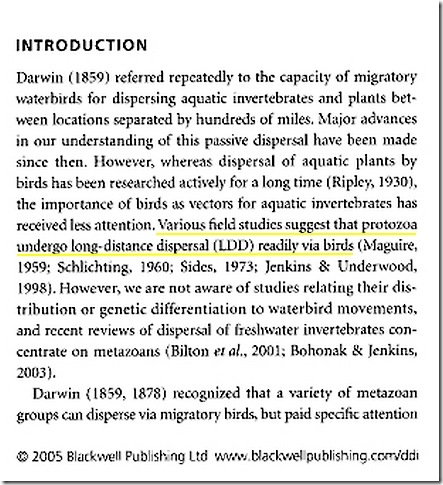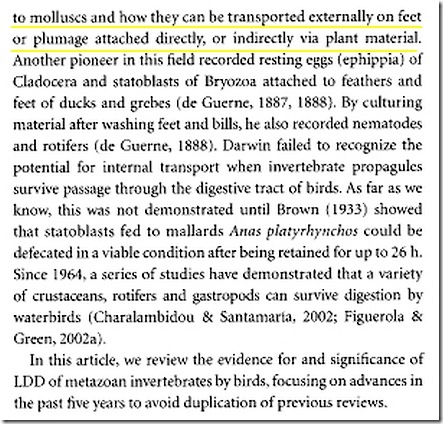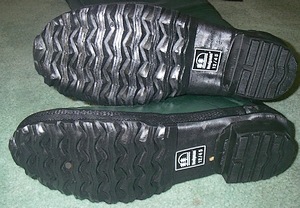 I’m one of those skeptical fellows that grows more so with each article on invasive species and the proposed felt sole ban. We’ve all seen plenty of “trust me” science and the rise of the conclusive inconclusive finding, and I’m beginning to doubt that the facts support a ban.
I’m one of those skeptical fellows that grows more so with each article on invasive species and the proposed felt sole ban. We’ve all seen plenty of “trust me” science and the rise of the conclusive inconclusive finding, and I’m beginning to doubt that the facts support a ban.
It started innocently enough, with New Zealand Mud Snails less than 5 miles from my house, it begged additional research into which of the other odiferous brown rivulets nearby were also affected.
As you might expect, science largely sticks to the pristine, ignoring my fetid little creeks as already lost to pollution and therefore unworthy.
But the research papers led me down a deepening rabbit hole, each ending in question marks and supposition rather than hard science and facts. Blame my upbringing, as the Haight Ashbury in the 1960’s taught us to question authority, and not be led by the nose.
So I continued to dig deeper.
Research documents on the current strain of invasives; Didymo, New Zealand Mud Snails, and the Quagga and Zebra Mussels, tell a different story than our angling press. Their conclusions are rather surprising given the constant barrage of Cal Trout, Trout Unlimited, and Federation of Fly Fishermen literature – which makes felt soles the overriding scapegoat for much of our unclean behavior.
What’s not in doubt is our role in the spread of invasives like Didymo and the Mud Snail. Waders and wading gear are a known “vector” by which unwanted organisms are transported from one waterway to the next. But felt soles don’t appear to be the primary issue – and in many studies were not even mentioned.
I remember the outrage of senators forced to vote on a thousand page stimulus plan posed by the Obama administration, how there wasn’t time to read it all before the vote ensued. It’s in my nature to ask, are we being railroaded to a similar speedy fix lacking proper scientific protocol with the proposed ban on felt soled wading shoes?
The documentation from the 2007 FFF Montana Symposium on invasive species lists fishing equipment, wading boot tops, and neoprene waders, as surfaces likely to carry the Didymo diatom, yet two years later only felt soles are facing a likely ban in 2011.
Cells are able to survive and remain viable in cool, damp, dark conditions for at least 40 days (Kilroy 2005). Fishing equipment, boot tops, neoprene waders, and felt-soles in particular, all provide a site where cells remain viable, at least during short term studies
Boot foot waders and neoprene wetsuits are outside the influence of fly fishing organizations as they’re used by many unrelated industries. Are we imposing our will on the only group that is semi-native to fly fishing, the detached boot – stocking foot wader makers?
… and does the science really conclude that’s the preferred alternative?
Why is there no push to change wading shoes uppers – rife with lace holes and layered tongues containing the same damp nooks and crannies as the felt sole?
Research suggests the upper lace area to be equally bad as the felt sole in terms of straining and capturing small organisms. A return to the welded boot foot wader would partially solve the issue, removing all laces and tongues and the damp areas surrounding them. Such a ban would be more appropriate than merely changing the sole and allowing the spread of invasives from the lace area, so why not ban both?
We’d all wear welded boot foot – cleated soles, like Dad did … a bunch of wading shoe manufacturers would go out of business, but we’d be doing our part to keep the environment sacrosanct.
… only manufacturers would never go for that, would they?
Didymo was first recorded in North America in 1894 (Cleve 1894-1896) at Vancouver Island in Canada, it’s native to Scotland and China, and didn’t get the invasive label in earnest until the New Zealand outbreak of 2004. It’s not considered an invasive to the Northwestern US, as its been here longer that some of us.
Many research papers suggest an incomplete knowledge of the Didymo diatom – why it’s initial presence is found frequently in dam tail waters, and while citing humans as a factor also raise the question about waterfowl and animal dispersal.
Many scientific journals postulate that it’s the evolution of the organism itself that has allowed its spread to warmer waters:
Why didymo all of a sudden changed into such an irritating and invasive species, no-one has yet figured out. The most prevalent speculation is we’re seeing the outcome of a biologically successful genetic mutation.
If true, then this becomes a completely different ball game – with birds, bears, and even wind able to carry a live diatom the short distance to the next creek.
The New Zealand government also supports a ban of felt soles, yet documentation from their website cites the lack of knowledge about Didymo in their 2004 research;
There appear to have been no attempts overseas to control or eliminate D. geminata, and no studies to date on how the species spreads.
As does the 2007 FFF Invasive Symposium document which cites, “ an organism for which we lack basic biological and ecological knowledge.”
Yet we’re so sure felt soles are the primary culprit we’re willing to ban them. I’ll have to ask “who’s so sure” because the scientific community hasn’t concluded anything.
The Didymo diatom is a single cell algae, small enough to be undetectable to the human eye, and easily carried on skin; a wet tee shirt, wading vest, or your flies. The New Zealand Mud Snail can be found in greater sizes, but studies of wading anglers find the most common size found clinging to waders and equipment is1mm or smaller.
Tests by the California Department of Fish and Game on wading gear found a correlation between New Zealand Mud Snails and wading boots, but more snails were found inside the boot than lodged in felt soles. (It’s my assumption that “padded insole inserts” were the authors term for felt soles.)
The majority of NZMS recovered were associated with wading boots. NZMS were observed on the tongue area of wading boots, associated with the laces or the area of the tongue that was tucked beneath the lacing eyelets. Large numbers of small NZMS were present inside of the boots, having worked down between the boot and the neoprene bootie of the wader. If the boots contained padded insole inserts, NZMS were also found underneath the inserts, associated with sand grains. NZMS were recovered from every treated set of wading gear. Numbers of NZMS per sample ranged from 1 to 227 with a mean of 33 (Appendix 2). Over 50% of NZMS recovered were < 1 mm in size
Wading anglers are one of the problems, but research cannot yet quantify how much of the problem we are – nor whether we’re the primary “pollination vector” or merely one of many culprits.
Boaters with their bilges and live wells can transport diatoms and aquatic hitchhikers far easier than we can. Species introduced into man made impoundments and lakes spill over the dam and populate tail waters with great glee – spreading further with each winter’s runoff.
But overlooked in all of this is the role of waterfowl – which can fly great distances and can transport algae and mollusks both internally and externally.


The above JSTOR abstract suggests both mollusks and diatoms can be hosted by birds over great distances and considerable time. It also suggests that we don’t the full story on the role of waterfowl on dispersion and additional research is warranted.
The New Zealand government study concurs, suggesting that the location of its initial outbreak was most likely spread via human vector, but doesn’t rule out the threat of additional spread via birds:
It is conceivable that clumps of D(idymo).geminata could pass live through the guts of birds or animals. Atkinson (1980) experimentally fed freshwater planktonic algae to ducks and found viable cells of the diatom Asterionella formosa in two cultures. However, because of the very long times involved in long-distance bird migration, this again seems most likely as a means of local transport rather than global dispersal. Another possible mode of local transport of diatom clumps could be on feet or feathers/fur of birds and animals. See Kociolek & Spaulding (2000) for more examples
Which speaks to the root of my issue; if the scientific community doesn’t yet know the answers why do angling organizations insist they do?
In conclusion, dispersal of D. geminata from its original geographical range into other parts of continental Europe and USA could conceivably have been assisted by avian vectors. However, this is a most improbable explanation for the sudden appearance of the species in New Zealand. The most plausible explanation is that the species has entered the region on a human vector. Birds and animals (as well as humans) could possibly be factors in any future dispersal within New Zealand.
I’m not content to follow the herd. Three years of college biology and chemistry doesn’t confer any special knowledge other than my ability to translate their vernacular. The science appears woefully incomplete – and someone has to point out the lack of facts in this Great Crusade.
Felt holds better than rubber, sticky or otherwise – and I don’t need science to tell me my ass hurts less when extremities are outfitted with felt and studs. There’s far too much “we’re not sure” in the supporting documentation than I’m comfortable with – suggesting some retired dentist or lawyer is trying to tell me I should wear – and not science.
Read about the subject and make up your own mind.
Considering that many of my locals waters contain invasives – and worse; Goat guts and dead cats – it’s no surprise that I am cautious and adopted the welded boot foot-cleated rubber soled wader. I won’t find out what I’m dragging with me for many years as the Pristine gets first crack at all the biologists. Rubber soles and welded foot ensure I don’t spread anything other than cigar butts for the moment.
No rocks and soft gravel bottoms allow me to stay dry in slippery rubber cleats. I have separate waders for trout fishing that are never used in local waters – they’re old and neoprene, but never will the apples and oranges intermix.
I have no plans to abandon felt if the ban is successful and the science is still conjecture. We once buffed the cleats off jungle boots and equipped them with indoor-outdoor carpet – and can do so again. A couple pairs of cleated boots to cover my local waters, and a couple more rug equipped for trout expeditions should cover me nicely..
… and I’ll scrub snot off out of them in between.
(The California Department of Fish and Game article should be read specifically as it also addresses the effects of cleaning products on both waders and wading boots and whether the materials were damaged by the cleaning protocol.)
Tags: New Zealand Mud Snail, Diatom, Didymo, waterfowl, JSTOR, California Department of Fish and Game, Federation of Fly Fishermen, Cal Trout, Trout Unlimited, pollination vector, felt soled wading shoes, jungle boots, Neoprene waders, Obama, Stimulus Plan, Quagga, Zebra mussel
 The left boot was taking on water from both heels and soles, I’d managed to wear through both, and the right boot was slurping water through both the uppers and heels, and all of this accomplished in two seasons.
The left boot was taking on water from both heels and soles, I’d managed to wear through both, and the right boot was slurping water through both the uppers and heels, and all of this accomplished in two seasons. I liked them so much I bought two more pair; one identical to the original, and a second lighter set – the Hodgman Bantam weight Nylon, featuring an identical instep and sole as the Wadewell variant.
I liked them so much I bought two more pair; one identical to the original, and a second lighter set – the Hodgman Bantam weight Nylon, featuring an identical instep and sole as the Wadewell variant.


 I’m one of those skeptical fellows that grows more so with each article on invasive species and the proposed felt sole ban. We’ve all seen plenty of “trust me” science and the rise of the conclusive inconclusive finding, and I’m beginning to doubt that the facts support a ban.
I’m one of those skeptical fellows that grows more so with each article on invasive species and the proposed felt sole ban. We’ve all seen plenty of “trust me” science and the rise of the conclusive inconclusive finding, and I’m beginning to doubt that the facts support a ban.

 With so few publicly traded companies containing an angling footprint, and with fishermen a closed mouth lot its always been a struggle to get a feel for the angling economy …
With so few publicly traded companies containing an angling footprint, and with fishermen a closed mouth lot its always been a struggle to get a feel for the angling economy … Once again I’m the center of attention as co-workers dance about me in utter horror.
Once again I’m the center of attention as co-workers dance about me in utter horror.
 Steeped in controversy yet the theory is simple; if garlic and lemon makes it palatable then it escapes the invasive label. If it’s too small to barbeque it’s destined to be fought tooth and nail.
Steeped in controversy yet the theory is simple; if garlic and lemon makes it palatable then it escapes the invasive label. If it’s too small to barbeque it’s destined to be fought tooth and nail. Africa and South America comprise the bulk of existing sales, but we’re just entering this new paradigm and have little idea how virulent the trend will become.
Africa and South America comprise the bulk of existing sales, but we’re just entering this new paradigm and have little idea how virulent the trend will become.